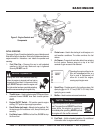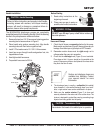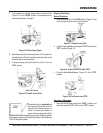
PAGE 22 — MQD2H/3H DIAPHRAGM PUMPS — OPERATION AND PARTS MANUAL — REV. #7 (05/24/13)
Rotation of Suction and Discharge Ports
In some applications, it may be preferable to have suction/
discharge ports rotated 90° (Figure 22) to be in-line with the
pump wheels. Perform the following procedure to rotate ports:
1. Remove the four hex head cap screws, hex nuts, flat
washers and lock washers from the pump base.
2. Push pump well downwards to separate from pump
base.
3. Rotate pump well 90° clockwise so that driver is
positioned over top of discharge plate.
4. Align pump well, pump base, and diaphragm with each
other. Once all components have been properly aligned,
reinstall the four hex head cap screws, hex nuts, flat
and lock washers and tighten securely.
Figure 22. Suction/Discharge Port Rotation
Clearing a Jam-Up
If large solids or an accumulation of sand, silt or other
sediment gather and become lodged in the pump well, the
plunger arm may be prevented from making a normal full
stroke. This action may cause the pump to stall, the crank
to slip on the output shaft, and ultimately cause damage to
the plunger arm.
Similarly, large damaging solids and debris may build in the
pump well and if not removed, may cause extreme damage
to the plunger arm and pump casing. If a jam or suspected
debris build-up occurs, the pump must be thoroughly cleaned
as described in the “Stalled/Stopped/Damaging Debris”
Section.
Stalled/Stopped/Damaging Debris
If Pump has stalled, stopped, or has been engaged in moving
heavy debris laden fluids, perform the following procedures:
1. Remove handle from pump. See Figure 6.
2. Remove the four hex head cap screws, hex nuts, flat
washers and lock washers from the pump base.
3. Push pump well downwards (Figure 23) to separate from
pump base.
4. Clean and remove all dirt and debris from pump well.
5. Align pump well, pump base, and diaphragm with each
other. Once all components have been properly aligned,
reinstall the four hex head cap screws, hex nuts, flat
and lock washers and tighten securely.
Figure 23. Pump Well (Clean-out)
During the course of pumping operations that include
heavy debris laden fluids, the pump well MUST be
checked for build-up of rocks, silt, sand and general de-
bris. Failure to clean out the pump cavity (well) could
result in damage to the plunger arm, and pump casing.
CAUTION - Stalled or Stopped Pump
MAINTENANCE
Pump jamming with an over-torqued lock screw (plunger
arm) may cause internal damage. Under torqueing may
allow the output shaft to spin and wear parts prematurely
causing replacement.
WARNING - Lock Screw Torqueing


















